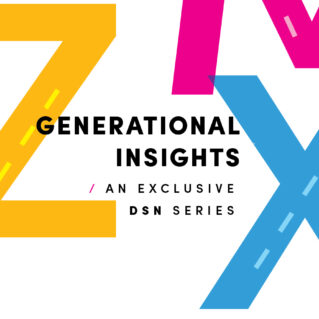Six unique ways companies have implemented this new structure and found success.
There is no longer a cookie cutter template for what equals success in direct selling. The channel’s once predictable, duplicatable system, is now populated with an array of infrastructures, each designed with the goal of expanding reach and attracting new customers.
For some brands, this new structure has involved earning a footprint in the ecommerce space by taking ownership of their Amazon storefronts and presence online. For others, remaining relevant has included the addition of retail and brick-and-mortar partnerships.
But one option continues to rise to the surface as a common pattern: the enhanced affiliate model.
Many direct selling leaders have begun to consider integrating or launching an enhanced affiliate model as part of or in addition to their existing brands. In fact, in a recent Direct Selling News survey of 45 direct selling companies, more than two-thirds of participants (67 percent) said they were at least considering how they could adapt and incorporate an enhanced affiliate model into their existing structure.
The Top 6 Affiliate Strategies
What is an affiliate model? Simply put, businesses offer affiliates a commission when they refer customers to their products or services. Businesses generate revenue that they couldn’t have reached otherwise, and affiliates make money on something they are already using or sharing.
The key difference this structure offers is that affiliates don’t grow their business through recruitment and team building. Instead, they focus on lead generation, customer loyalty and partnership with brands. Today, direct selling companies who have successfully completed this transformation typically reside in one of six categories.
1/ No Direct Selling History
This is the basic affiliate model structure. These companies pay commissions on revenue generated from sales, but they also can offer a tiered affiliate model that offers commissions to affiliates for sales made from another affiliate they referred, including SellHealth, Builderall, Market Health, Organica Naturals, Intechra Health and service-based companies like Fiverr, ClickFunnels, Travelpayouts and Grammarly.
While none of these companies would consider themselves a direct selling operation, all of them are running an enhanced affiliate model structure, some with tiers that extend two generations.
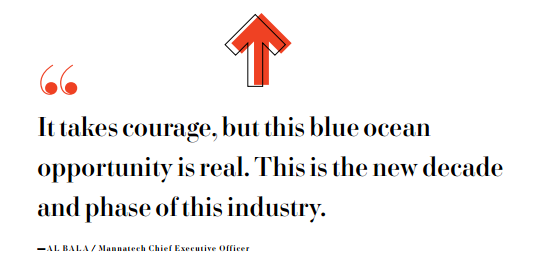
2/ Optimized Front-End Direct Selling Models
USANA, 4Life, pawTree and BELLAME have all implemented this new compensation model approach into their existing structures. With this method, those interested have the option to join as an affiliate whose sole task is to sell, but at any point in their affiliate journey, they also have the option to sign up as a business builder or direct selling distributor.
pawTree, who announced this switch in the first quarter of 2023, pointed to it as the most efficient way to attract and retain a new segment of marketers who don’t lean into traditional direct selling messaging.
“The lynchpin for long-term sustainable growth is getting lots of people making $300 to $500 a month in a reasonable amount of time with a reasonable amount of effort,” said Roger Morgan, pawTree Founder/CEO. “We want to help them make enough money, faster, so that they stick with it.”
USANA created a new position on the company’s compensation plan called “affiliate,” a product sharer and brand influencer who earns a 20 percent sharing bonus on all sales.
“It’s really creating a whole new customer segment target for your company,” said Jeannie Price, USANA Executive Vice President of Sales. “We have a separate portal, a simplified website. We’ve created sharing tools and assets for them and use a completely different communication approach with our affiliates than our distributor base.”

4Life, who also chose to optimize the front end of their compensation model, wanted to reimagine its legacy programs to maintain its competitive nature and generational relevance. They developed Preferred Customer incentives including free shipping, wholesale pricing, loyalty points, bonus products and instant discounts. Affiliates also have access to a Rapid Rewards program that pays builder bonuses, new rank recognition, incentive trips and more.
At the beginning of 2022, BELLAME was taking note of how fluid the entrepreneurship landscape was becoming and developed proprietary lead capture and lead generation tools that an established affiliate marketer would expect. They removed startup fee barriers, making it free to join for anyone, regardless of whether they were interested in being an affiliate or building a business and removed qualifications to earn money.
“Whatever label you use—affiliate marketer, digital marketer—we knew we needed to make room for it,” said Melissa Thompson, BELLAME Founder/CEO. “They enjoy the entire compensation model. And we never charge one penny—not a sign-up fee, transaction fee, renewal fee or tool fee. We have been able to attract people who are not normally interested in our industry at all.”
3/ The Standalone Sister Company
This avenue is a way for existing direct selling companies to start a new entity as a wholly owned subsidiary offering a new brand and an affiliate compensation model separate and apart from the existing legacy company while leveraging the established brand’s powerful reputation, expertise and logistical strengths.
Mannatech led the way with this “best of both worlds” approach through the formation of a subsidiary that will serve as its innovation hub. Trulu, the new resulting brand, is expected to build upon the legacy company’s existing strengths, utilize operational assets and enhance relevancy.
This new subsidiary offers a complimentary pathway to support growth in customer acquisition and retention, revenue, profits and value but does not diminish or detract from the company’s investment in direct selling.
“We will continue to transform certain aspects of the current model, however, our investments in Trulu will not distract from our responsibilities to Mannatech,” shared Al Bala, Chief Executive Officer. “It takes courage, but this blue ocean opportunity is real. This is the new decade and phase of this industry.”
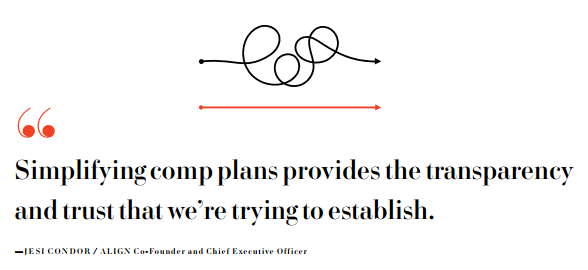
4/ The Hybrid Startup
Eliminating confusion is the key focus of this strategy. Most of these brands have some connection to the direct selling industry and have decided to start an entirely new venture using the tiered affiliate model as the backbone of their business.
For ALIGN Co-Founder and Chief Executive Officer Jesi Condor, her experience as a leader in the sales field taught her what worked and what didn’t when it came to compensation.
“I would always look at my check and it averaged out to three percent,” Condor said. “My question was always ‘Why is there this giant chart of complication for me to ultimately earn three percent?’ So, what we tried to do was eliminate that confusion. Our entire comp plan is volume-based; it’s very simple. Simplifying comp plans provides the transparency and trust that we’re trying to establish.”
Amanda Tress, Founder/CEO of FASTer Way to Fat Loss, developed her health and fitness-focused affiliate program with a customer journey that offers the opportunity to grow from a six-week orientation program to a VIP monthly membership and, ultimately, a certified coach. Coaches have the chance to earn 50 percent commission on their new client signups and 50 percent commission on their clients’ VIP monthly membership fees. They can also help their clients become certified coaches and earn 10 percent of their sub-affiliate sales.
Tress builds loyal customers through micro-influencers, called Ambassadors, who pitch strategic micro-commitment campaigns, like a $19.99 lead magnet that requires minimal time and investment. “What we’ve found is that micro-influencers truly do not care about a recurring revenue model,” Tress said. “They simply want that one-time commission on the front end.”
5/ The Relaunched Affiliate Model
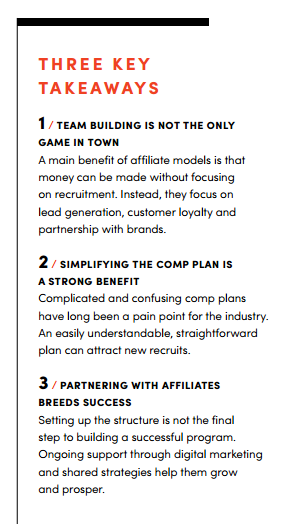
These companies have transitioned completely out of direct selling and are fully embracing the affiliate structure as their sole mode of operations. SimplyFun announced this switch in February of this year, saying it would phase out its existing direct sales model to instead focus on a new affiliate program that offers affiliates a ten percent commission on purchases made through their personalized link and bonuses of up to 25 percent commission based on their total monthly sales.
Pure Romance announced this change in May 2023 stating it was “shifting away from the multi-level sales model” in favor of an omnichannel approach now that only one percent of its consultants were receiving downline commissions.
But the most experienced leader in this path is undoubtedly AdvoCare, who, as the result of pressure from and litigation with the Federal Trade Commission (FTC), switched to a direct-to-consumer, single-tier marketing compensation plan. Today, the company has found that its affiliate incomes are five times higher than they were in 2018, before this switch, and that affiliates say they feel less pressure with the removal of team building as a requirement for growth.
“I know that we are not all the same, and we did go through it in a way that I would not wish upon my worst enemy,” said Christina Helwig, AdvoCare Senior Vice President, Sales and Marketing. “At the same time, we found success. Sometimes you take a little risk and find traction. At the end of the day, leaning into our customers has resulted in success—not only for our distributors, but for our brand.”
6/ The Rapid-Fire Test and Launch Model
Messaging in direct selling can feel sluggish as executive teams work to spread the communications like a game of telephone, passing it through the top leaders who then share it with their downline.
“In the traditional direct selling world, marketing teams work really hard to define their messaging and create all the collateral to launch to the field,” said Paul Adams, President and Owner of Adams Resource Group. “Then, when launched, it takes quite some time to get the messaging into the hands of the field. Does this take weeks? Months? What if it didn’t work as well as expected? That is a lot of time lost.”
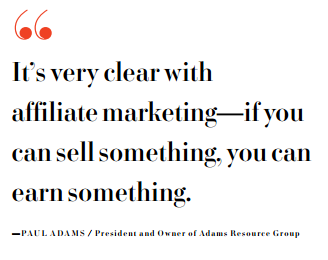
Enhanced affiliate marketing whittles down that message refinement process to create a leaner, more responsive communications tool. Within 30 days or less, a new website, shopping cart and product can be exposed to a large group of potential affiliates, assuming that the pay structure is already in place. No genealogy, no lengthy IT integration, no games, training sessions or long-term commitments necessary. This makes it simple to test the efficacy of a message, then adjust, refine and adapt.
Opening up a new domestic market or expanding internationally might cost seven figures with a traditional direct selling template, but with the enhanced affiliate approach, leaders can test the market on a trial basis at a fraction of the cost. By advertising in that market and then paying affiliates to get involved, companies can cheaply assess if the market is warm for a certain product or messaging style.
“What we have found is that when affiliates and potential affiliates with past experience in direct sales are no longer enticed by the long-term business building model, they are very interested in leveraging their existing network of followers and offering products they believe in,” Adams said. “It’s very clear with affiliate marketing—if you can sell something, you can earn something.”
Brave New World
As brands seek to optimize their offerings for the next generation of consumers by making the direct selling model more appealing, the most powerful behavior the industry possesses is knowing how to create a movement that spreads like wildfire. But that magic only happens when combined with the critical elements of connection and community.
Even as the industry considers how it can integrate and embrace the enhanced affiliate model, it is imperative that it remembers how to craft a sense of belonging for and connection between its affiliates, distributors and customers.
From the July/August 2023 issue of Direct Selling News magazine.

